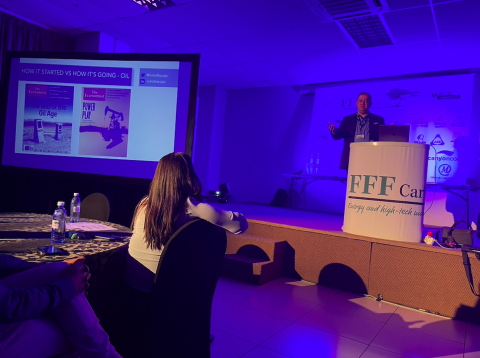SA Mining
Stimulating The Economy
By: Nelendhre Moodley
Following the devastating impact of COVID-19, government has identified infrastructure development as a key enabler to economic recovery and earmarked R2.3 trillion to stimulate growth. SA Mining recently caught up with Tomas Badholm, Africa Region head at Bombardier Transportation, to chat about developments in the rail sector and how it can help revitalise growth.
How important is freight rail to African countries’ economies?
It’s critical to the ongoing development of economies, especially in the wake of the COVID-19 pandemic. We believe governments should be eyeing a significant road-to-rail shift. This would reduce the cost of doing business, promote international trade, reignite economic growth, and mitigate the impact of climate change given that rail transport is less carbon-intensive than road transport. All round, key economic and social drivers need to be considered.
Most stakeholders understand the need for rail but funding remains a burden. There is a renewed importance for public private partnerships (PPPs) to help advance freight rail in Africa, as this would help accelerate the development of the economy and create employment opportunities across the continent.
PPPs are essential to help continue building and implementing new infrastructure, to allow for freight rail to take place across countries, renovate older infrastructure, and also operate and maintain existing transport infrastructure and facilities. What is needed now is a focus on unlocking the wealth of capabilities, expertise and funding that exists in the private sector.
Is there opportunity to expand the rail offering to accommodate a variety of other products not currently exported via rail?
Typical products that are currently transported via rail in Africa include ore from the mines, commodities, agricultural and industrial products and consumer goods. There is an opportunity to expand on this list but we would need the infrastructure to support it. As one ventures into increasingly complex products, time sensitivities and logistical conditions become a major factor. Furthermore, we have to think about safety. Are we providing the security for high-value products that manufacturers want to see?
Swift transportation of products between countries (which would be possible once the African Continental Free Trade Area (AfCFTA) agreement has been advanced) is a reality, but we need to partner with governments to ensure that we are creating an environment that makes rail an attractive mode.
For new rail projects on the continent, there is a focus on increasing the average speed for freight trains to make rail transport more attractive and times between the destinations more predictable. Another important factor is to reduce the time for custom clearance between landlocked countries, as this can make freight transit more difficult.
In terms of innovation and technology, how fast is freight rail advancing? What key developments have recently been advanced?
Automation, liquid natural gas, biodiesel and hydrogen fuel are evolving quickly; this is certainly the space to watch. These can all be complementary solutions to increase the reach for the railway where electrification is not a financially viable option due to high investments in infrastructure.
Liquid natural gas is another factor being explored in trains, as the sector is looking to reduce fuel prices and emissions and using this gas allows them to do so. However, additional safety regulations would need to be created for organisations that would introduce this into their product offering to protect staff, as it can be dangerous.
Hydrogen fuel cells are another breakthrough in the industry, as they provide continuous power supplemented by a battery for peak power. Hydrogen fuel cells are attractive as they produce zero emissions other than water and are more energy-efficient than combustion engines, as liquid hydrogen can be created using renewable energy resources, which makes it attractive to train manufacturers.
Biodiesel is another renewable energy source, with sources such as rape, soya, corn and palm oil available on the continent. This can be an alternative source of fuel for a modern fleet of locomotives, if investment in biodiesel plants is put in place.
Does the Agreement Establishing the African Continental Free Trade Area (AfCFTA) have any impact on freight rail?
Africa is on the cusp of launching a free-trade zone that could meaningfully boost economic growth and unlock the continent’s vast potential.
Slashing intra-regional trade tariffs is an important first step, and one that should be applauded – but other interventions are needed for the AfCFTA to be a success. Perhaps the most pressing requirement is the need for better transportation links between African states, particularly in the form of rail networks. So yes, the AfCFTA will put pressure on good rail infrastructure (including freight rail).
A reliable rail network would allow for the efficient movement of goods across the continent, while also improving Africa’s links to the rest of the world, particularly the continent’s landlocked nations. Rail is also a sustainable solution given that it is far more environmentally friendly than road and air transport – Africa’s natural environment is one of its greatest assets, and it must be protected.
Ultimately, rail’s contribution towards an integrated transport network will help Africa to attract investment and to be competitive in the global trade arena.
How competitive is your industry and what is Bombardier’s competitive edge?
The rail industry is very competitive, as it is filled with long-standing reputable railway players, as well as emerging players that are eager to collaborate with governments and the private sector.
Innovation and collaboration are key to surviving in the railway business.
Bombardier Transportation has a competitive edge as we continue to provide innovative and integrated rail mobility solutions that create substantial benefits for operators, passengers and the environment.
For the mining industry, Bombardier provides cost-effective, streamlined and flexible solutions in its portfolio that optimise the movement of ore and freight, within a mine, from mine to port and across country borders, making the company a key contender in the freight railway industry.
The efficient movement of freight 24 hours a day, 365 days a year is essential to a modern and productive resource industry. Bombardier specifically designs industrial and mining rail control solutions to optimise and maximise the rapid transport of raw materials to enable fully automated, continuous, efficient and streamlined productivity. We ensure that our solutions provide greater cost-efficiency, speed and capacity as well as increased availability.
Bombardier’s globally proven INTERFLO rail control solutions are the optimal choice for moving goods efficiently along heavy haulage mainlines, using the latest communications-based technology with a minimal wayside equipment footprint, while offering maximum rail capacity.
As well as offering the latest in mainline rail control solutions that support national and cross-border freight operation, leveraging the quality of our automated systems, we have a dedicated rail control solution helping mining operators to maximise their assets and capacity, intensifying ore extraction and freight transportation.
The dedicated INTERFLO 150 solution for industrial and mining operations provides a step change in rail productivity by enabling flexible and automated operations, fully integrated integration with a mine’s loading and unloading systems. These systems achieve significant productivity benefits and major safety improvements, enhancing capacity in operations within the mine and from mine to a next destination. They are also scalable, making it cost-effective in mines of varying size and grades of automation around the world.
What are some of the challenges faced by freight rail operators?
Investment in the railway sector has always been a key challenge for the industry, and with COVID-19 it has made it even more of a challenge as the sector (including the freight rail) relies on huge initial capital investments.
With African governments’ resources increasingly constrained due to the outcome of the COVID-19 crisis and the responsibilities they have towards their citizens, there’s a reduced appetite to invest in freight rail. One solution that could be further explored is the public-private partnership approach.
Other challenges for the freight rail industry include infrastructure development and maintenance, service delivery issues, theft or pilferage problems, government policy as well as organisational policy issues and the preference that organisations have to transport goods via trucks.







 Sign-up and receive the Business Media MAGS newsletter OR SA Mining newsletter straight to your inbox.
Sign-up and receive the Business Media MAGS newsletter OR SA Mining newsletter straight to your inbox.